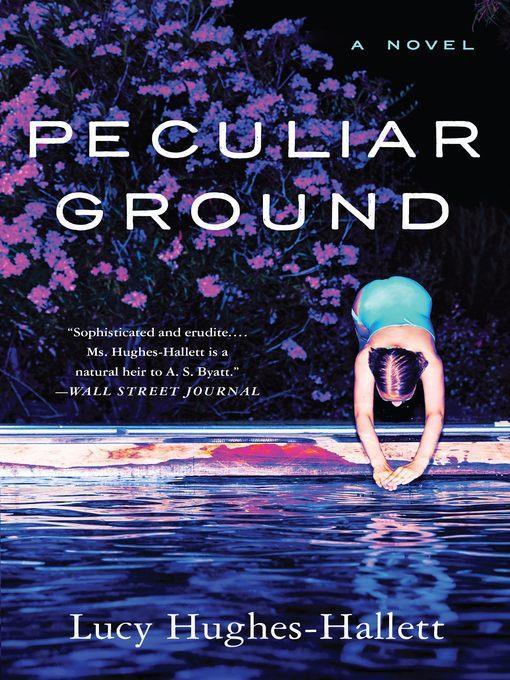
Peculiar Ground
A Novel
کتاب های مرتبط
- اطلاعات
- نقد و بررسی
- دیدگاه کاربران
نقد و بررسی

September 1, 2017
Winner of the Samuel Johnson Prize for The Pike: Gabriele D'Annunzio, Hughes-Hallett received sparkling reviews in the UK for this fiction debut. It opens with the 17th-century construction of a great house named Wychwood, whose high walls shelter the inhabitants after decades of bloody civil strife. Jump forward to the last half of the 20th century, with the Berlin Wall rising and falling even as Wychwood's current inhabitants try to deny the real world.
Copyright 2017 Library Journal, LLC Used with permission.

November 6, 2017
Author of an acclaimed biography of the poet Gabriele D’Annunzio, Hughes-Hallet offers an enjoyable, sprawling epic debut about an enclosed paradise. Populated by a large cast, its subject is singular: Wynchwood, a lavish English country estate that weathers centuries of upheavals, from civil war to its transformation into a theme park for the aristocrat-obsessed. The novel concentrates on two historical eras. The 17th-century scenes, which bookend the novel, focus on John Norris, a prim landscape architect with extravagant Eden-like visions for the estate. Magnificent though his designs may be, the outside world creeps in, notably in the form of tragic accidents and the plague that ravaged England in 1665. These sections, which include flourishes of historical and cultural detail (witchcraft, folklore, secret religious sects), paint a vivid picture. The novel’s middle episodes, which check in on the fast-living set congregating at Wynchwood during key moments throughout the Cold War, are the highlight: consistently witty, they are reminiscent of another country house saga, Alain Hollinghurst’s The Stranger’s Child. Hughes-Hallett effectively expands the domestic drama to touch on class resentment, religious conflict, and international affairs. Her Wynchwood is a remarkable, ambivalent creation, “at once a sanctuary and place of internment,” and readers will delight at strolling its grounds under her guidance.

November 1, 2017
An award-winning historian (Gabriele D'Annunzio: Poet, Seducer, and Preacher of War, 2013, etc.) makes her fiction debut with a story vast in scope but intimate in its details.The year is 1663. England's civil war has ended. Newly returned from exile, royalist Arthur Fortescue, the Earl of Woldingham, has hired the landscaper John Norris to turn his ancestral home into a private paradise. As he is drawn ever deeper into the life of Wychwood, Norris discovers that the Earl's plan to enclose his new gardens, fountains, and tree-lined avenues within a wall will be a disaster for the religious dissenters who live and worship in the forest around the estate. The Earl's land, Norris learns, is crisscrossed with secret paths used by people scorned and abused for their faith. When Hughes-Hallett brings the narrative 300 years into the future without first resolving this issue, the shift feels abrupt. But it soon becomes clear that the temporal leap makes perfect sense: the issue of the wall is unresolved because it is irresolvable. Who owns the land, who has right of way, what the very wealthy owe everyone else: these are questions that never go away. Hughes-Hallett explores how the past persists in other--more personal--ways as well. Relationships between masters and servants recapitulate themselves across generations. Family tragedies repeat with slight variations. Wychwood remains a world unto itself even as people come and go and the property changes hands. Time feels like a circle, and the novel brings us to 1989 before taking us back to the 17th century. There are multiple narrators and perspectives here, but the text never feels cacophonous because each voice is so exquisitely limned. Hughes-Hallett's choice to turn minor players into major characters is especially satisfying; of course those who rely upon the wealthy and powerful must be canny observers of the wealthy and powerful. The novel is a pleasure to read for the loveliness of its language. It's also a timely meditation on walls, on what they keep in and what they keep out.A first novel stunning for both its historical sweep and its elegant prose.
COPYRIGHT(2017) Kirkus Reviews, ALL RIGHTS RESERVED.

December 1, 2017
Hughes-Hallett's ambitious novel begins in 1663. The British monarchy has been restored after years of civil war. Norris, a landscape designer, arrives at Wychwood to refashion the gardens and oversee the construction of a wall that will completely enclose the grounds. Much of Norris' design still stands 300 years later, when Wychwood is a sanctuary (or, as one character puts it, a sanctuary and a place of internment ) for a new generation, the generally upper-class Wychwood stalwarts, whose lives Hughes-Hallett traces from 1961 to 1989. Also on hand are characters descended from the estate workers of Norris' time, in tune with the past and Wychwood's attendant legends. Witchcraft, ancient Roman mosaics, the rise and fall of the Berlin Wall, and the stirrings of Islamic fundamentalism all come into play amid themes of continuity and change and the author's frequent use of water as a symbol. The novel's final section returns the reader to 1665, when Wychwood is seen as a refuge against the plague. Give this to readers who enjoy the works of A. S. Byatt.(Reprinted with permission of Booklist, copyright 2017, American Library Association.)

























دیدگاه کاربران